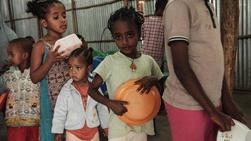 Displaced children wait for breakfast provided by volunteers in Mekele, the capital of Tigray region, on June 23. (YASUYOSHI CHIBA / AFP)
Displaced children wait for breakfast provided by volunteers in Mekele, the capital of Tigray region, on June 23. (YASUYOSHI CHIBA / AFP)
Though humanitarian access is significantly improving within Ethiopia's war-torn Tigray region where hundreds of thousands of people are facing famine, the flow of humanitarian supplies remains insufficient.
According to the United Nations Office for the Coordination of Humanitarian Affairs, only 30 trucks with humanitarian supplies can be scanned each day under the current procedures. However, at least 100 trucks of food, nonfood items and fuel are required daily.
"From July 16 to Aug 15, 318 trucks with humanitarian supplies entered Tigray. This is a fraction of the required humanitarian cargo to meet the mounting needs," said the UN agency in a news conference on Wednesday. "Humanitarian operations are also severely affected by lack of stocks, cash, banking services, fuel and telecommunications. Transport of information and communication technology equipment is still prohibited."
The agency said humanitarian access into the region is still restricted via the Afar region road, which is only partly opened due to insecurity.
Getting more supplies and workers into the region is as an urgent requirement, along with restoring electricity and telecoms, and ensuring that cash and fuel are available to support the response.
In spite of the challenges, the agency said staff rotation is improving, with the UN humanitarian air service now operating two regular flights per week as planned.
As of Monday, the number of UN staff supporting the humanitarian response in Tigray region stood at 457, of which 105 are international staff. Local staff make up the rest of the team.
Currently, 5.2 million people are in need of humanitarian assistance in Tigray.
In its situation report last week, the UN agency said only 25 to 50 percent of average cereal production is expected to be available this year, as farmers in many parts of Tigray did not plant during the current rainy season.
In addition to the nine-month conflict in Tigray, the country is experiencing increased displacements due to spillover of the conflict into the neighboring Afar and Amhara regions.
Nearly 76,500 people have been displaced in Afar, following the movement of Tigray forces into Yalo, Awra, Gulina, and Ewa districts.
In Amhara, an estimated 200,000 people have been displaced in a number of conflict-affected areas in North Gondar, Central Gondar, Wag Hemra, North Wollo, and in various pockets across the region.
edithmutethya@chinadaily.com.cn


